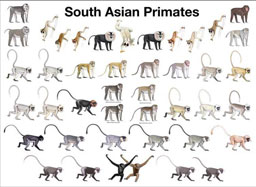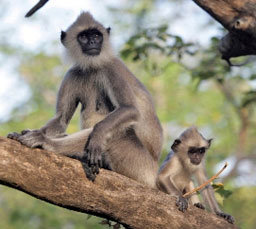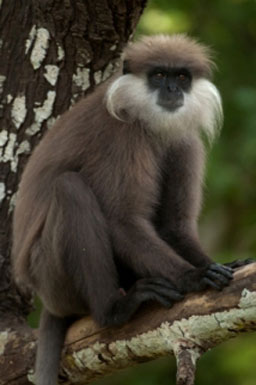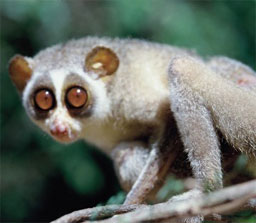
Wildlife at Polonnaruwa
- Wildlife of Sri Lanka
- Polonnaruwa: Hub for Wildlife
- Primates
- Toque Macaque
- Hanuman Langur
- Purple-Faced Langur
- Loris
- Other Mammals
- Birds of Sri Lanka
- Reptiles, Amphibians & Fish
- Invertebrates
- Ecology of Dry Evergreen Forest
Primates
Sri Lanka has the greatest diversity of primates in South Asia
Sri Lanka takes up only about 1.5% of the land area of South Asian countries where primates occur. Yet the island harbors 30% of all primate forms of South Asia (13 of 43 subspecies).
Primates at Polonnaruwa (4 species)

Photo: Wolfgang Dittus
Toque Macaques (Macaca sinica)
The species owes its popular name to a type of hat, known as “toque” that was popular in 16th century England. The head hair of these macaques is arranged in a circular whorl radiating outward from a central spot on the crown. Their coiffures are highly variable among individuals as well as regions. The monkeys are colorful; females tend to have red faces with blue eyelids, black pigmented lips and ears and a golden or orange hue to their brown pelage. The males lack the red faces, but are twice the size of females and have long sharp canine teeth that are used as lethal daggers in battles with other males for mates. Many males die in such contest so that there are twice as many females as males among adults in their society.
Toque macaques live in social groups, of normally about 25 members comprising one to three matrilineal families, and one or more adult males that have immigrated from other social groups. Macaque societies are highly cohesive in their activities and closed or xenophobic to outsiders. Each group confines its movements within a large area of forest, knows as its home range, and it travels widely in search of a variety of food, mostly fruit, tender vegetation and insects.
They are an intelligent primate with active social lives and an ability to adapt rapidly to environmental challenges.
Sri Lanka has three main climatic zones each being characterized by its own typical flora and fauna. The macaques occur as three different subspecies; the lowland dry zone (Macaca sinica sinica), the lowland wetzone (M. s. aurifrons) and the montane race (M. s. opisthomelas).

Photo: David Barron
Gray or Hanuman Langurs (Semnopithecus priam)
These monkeys appear regal against their feistier and smaller sized cousins, the macaques. The have light gray fur, black skinned faces and an elf-like peaked cap. Like macaque they too live in social groups, numbering 5 to over 50 members, and one or more adult males. They occupy prescribed home ranges and are often seen defending their grounds against other gray langurs in spectacular turf battles where they crash through the trees breaking branches and uttering loud “whoop-whoop” calls. The langurs have a specialized gut that allows them to digest mature leaves – an ability that the macaques lack. Their social life is somewhat simpler that that of the macaques, but langur males are no less tame and have a reputation for killing the infants sired by rival males.
Gray langurs range widely on a daily basis and spend much time foraging on the ground and in the lower layers of the forest.
The hanuman langur occurs as only one subspecies (S. p. thersites) that is confined to the extensive dry-zone lowlands.

Photo: Barney Wilczak
Purple-Faced Langur (Semnopithecus vetulus)
Like the Hanuman langur, they too have a specialized gut that allows them to digest mature leaves. They are distinguished from the Hanuman langur by their dark, charcoal grey pelage, black skinned faces and conspicuous white beards. In their habits they are similar to the Hanuman langur, but they tend to confine their activities to the upper canopy of the forest and live in small groups dominated usually by a single adult male. They don’t range as widely as the gray langurs, but live in small territories that they defend vigorously against neighboring purple-faced langur groups. Their territorial whoop calls echo through the forest in the early morning hours.
The purple-faced langur occurs as four different subspecies on the island: S. v. philbricki of the lowland dry zone, S. v. monticola of the hill zone, S. v. vetulus of the lowland rainforests south of the Kalu Ganga River, and S. v. nestor north of that river. The vetulus race is distinguished by white patches on the thighs and lower back, the white patches being far less distinct in the nestor race, and altogether lacking in the other two subspecies.

Photo: Dr. Wolfgang Dittus
Slender Loris (Loris lydekkerianus)
Lorises are small bodied, brown-gray-orange colored primates that are active at night. In keeping with their nocturnal habits they have huge eyes, and they move through the shrubs and trees in a slow deliberate manner. They live either singly or on small family groups of a female and one or two of her young. They eat primarily insects and small prey, as well as fruit.
The lorises are an evolutionary conservative group that represent the stock of pre-monkeys (prosimians) from which other primates evolved. In Sri Lanka they occur as two species with subspecies Loris tardigradus of the lowland rainforest and L. t. nycticeboidese of the hill zone. The second species is Loris lydekkerianus with two subspecies L. l. nordicus of the lowland dry zone, L. l. grandis of the intermediate zone
